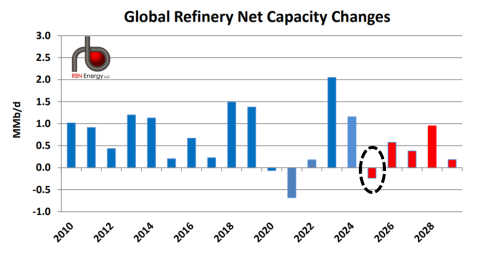Refineries in Europe, Latin America, Russia and China are facing a host of issues that could ultimately benefit U.S. refiners. Europe has high operating costs and political pressures. Attacks have damaged Russia’s refineries, and the country continues to get blasted with steeper sanctions. China’s aging plants are closing and there are no new large-scale projects on the horizon. Latin America lags in capacity growth. In today’s RBN blog, we look at how these global issues are boosting opportunities for U.S. refiners.
First, we’ll offer a refresher of the U.S. refining industry before we address the global arena. As we discussed in Us and Them, the industry has undergone a number of changes in recent years, and more turbulence looks likely as global economic and trade patterns shift and the energy transition moves forward. For some U.S. refineries, this has led to closures due to weak profits, rising regulatory costs and declining demand for products, particularly gasoline. But other refineries have prospered and even invested in expansions. The U.S. refining industry has evolved into the most competitive in the world, and the issues and challenges faced by other countries will likely benefit U.S. refiners.
While 2025 will end up with about 1.2 MMb/d of gross capacity additions worldwide, significant shutdowns will also take place in the U.S., Europe and China, resulting in a net decrease in capacity of about 240 Mb/d (see dashed black oval in Figure 1 below). As detailed in the most recent Future of Fuels report from our Refined Fuels Analytics (RFA) practice, we’ll look at the challenges facing Russia, Europe, China and Latin America, and spell out how the political pressures and potential closures could set up U.S. refiners for growth.
Figure 1. Global Refinery Net Capacity Changes. Source: RFA
We’ll break down each region, starting with Russia.
Russian refineries have faced relentless Ukrainian drone attacks that have knocked out at least 17% (roughly 1.1 MMb/d) of Russia’s total refining capacity, sparking fuel shortages and panic buying in its southern regions. Since June, Ukraine has struck 10 major refineries, including sites in Volgograd, Saratov, Syzran, Ryazan and Novokuibyshevsk, with some of these facilities being forced offline for weeks. Russia responded by banning gasoline exports in July and shifting crude oil flows toward China and India, despite U.S. pressure to dial back those sales.
Join Backstage Pass to Read Full Article











